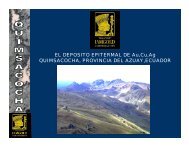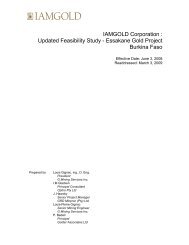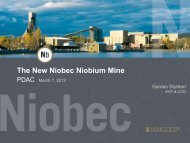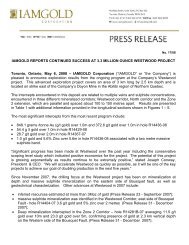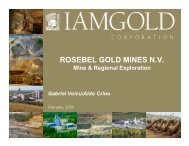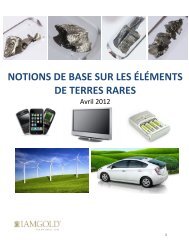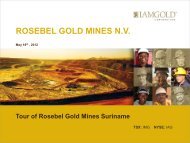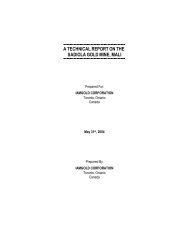NI 43-101 Technical report, Surface diamond drilling ... - Iamgold
NI 43-101 Technical report, Surface diamond drilling ... - Iamgold
NI 43-101 Technical report, Surface diamond drilling ... - Iamgold
You also want an ePaper? Increase the reach of your titles
YUMPU automatically turns print PDFs into web optimized ePapers that Google loves.
R a r e E a r t h E l e m e n t E x p l o r a t i o n P r o g r a m M a r c h - 2 0 1 3<br />
W i n t e r - S u m m e r 2 0 1 2 P a g e | 23<br />
Late, 1-3 mm wide, partially to completely filled veins, containing euhedral calcite, barite<br />
and fluorite cut across the brecciated and also across the unbrecciated dolomitite (Fortin,<br />
1977; Fournier, 1993).<br />
The uppermost 60 m of the REE Zone were heavily weathered to an orange or red color as a<br />
result of exposure of the carbonatite to the atmosphere prior to deposition of the Trenton<br />
limestone (Figure 7). At depth, red staining of carbonates is a more local phenomenon, and<br />
the characteristics of the breccia are easier to recognize (Dénommé, 1985; Fournier, 1993).<br />
At the microscopic scale (Fournier, 1993), dolomitite clasts range from an Mg-rich variety to<br />
a more iron-rich variety containing significant manganese. They make up a solid solution<br />
between dolomitite and ankerite, but some crystals of magnesian siderite are also found.<br />
The carbonates cement of the breccia varies from ferroan dolomite to ankerite but is poorer in<br />
Ca than the associated clasts.<br />
The chlorite is brownish colored, iron-rich and locally comprises up to 20% of the rock by<br />
volume in interstices between carbonates grains. This contrasts with the Mg-rich, greenish<br />
variety, which replaced phlogopite in the Niobium Zone (Fournier, 1993).<br />
The apatite, which classifies as fluorapatite, has higher fluorine content and a more<br />
stoichiometric phosphorous content in the REE zone than in the Niobium zone. However, the<br />
REE content of apatite from the two zones does not differ significantly.<br />
The principal REE minerals are fluorocarbonates and take the form of needles in radiating<br />
bundles or in parallel growth and measure a few microns in diametre and up to 20 micron in<br />
length. REE fluorocarbonates minerals are concentrated mainly in the breccia matrix where<br />
they are associated with either chlorite, hematite, dolomite or organic matter.<br />
The monazite [(REE,Th) PO 4 ] occurs as irregular, micron size grains spatially associated<br />
with parisite but enclosed in the bastnaesite; and the thorite (ThSiO 4 ) as micron size, opaque,<br />
grains set in either chlorite or organic matter.<br />
The oxide minerals in the REE zone, the hematite, is found either as discrete fine (



